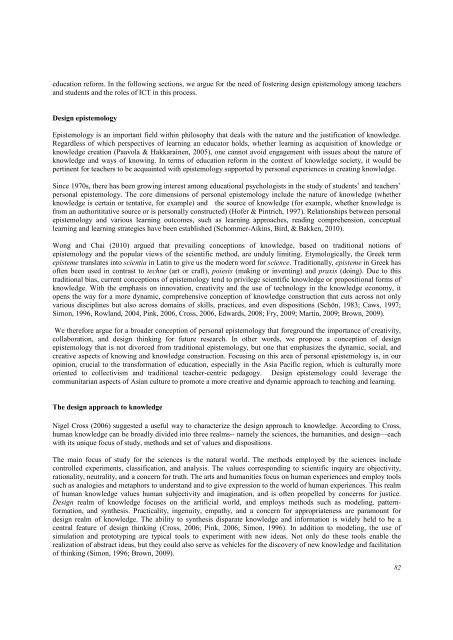Download Complete Issue in PDF - Educational Technology & Society
Download Complete Issue in PDF - Educational Technology & Society
Download Complete Issue in PDF - Educational Technology & Society
You also want an ePaper? Increase the reach of your titles
YUMPU automatically turns print PDFs into web optimized ePapers that Google loves.
education reform. In the follow<strong>in</strong>g sections, we argue for the need of foster<strong>in</strong>g design epistemology among teachers<br />
and students and the roles of ICT <strong>in</strong> this process.<br />
Design epistemology<br />
Epistemology is an important field with<strong>in</strong> philosophy that deals with the nature and the justification of knowledge.<br />
Regardless of which perspectives of learn<strong>in</strong>g an educator holds, whether learn<strong>in</strong>g as acquisition of knowledge or<br />
knowledge creation (Paavola & Hakkara<strong>in</strong>en, 2005), one cannot avoid engagement with issues about the nature of<br />
knowledge and ways of know<strong>in</strong>g. In terms of education reform <strong>in</strong> the context of knowledge society, it would be<br />
pert<strong>in</strong>ent for teachers to be acqua<strong>in</strong>ted with epistemology supported by personal experiences <strong>in</strong> creat<strong>in</strong>g knowledge.<br />
S<strong>in</strong>ce 1970s, there has been grow<strong>in</strong>g <strong>in</strong>terest among educational psychologists <strong>in</strong> the study of students’ and teachers’<br />
personal epistemology. The core dimensions of personal epistemology <strong>in</strong>clude the nature of knowledge (whether<br />
knowledge is certa<strong>in</strong> or tentative, for example) and the source of knowledge (for example, whether knowledge is<br />
from an authorititative source or is personally constructed) (Hofer & P<strong>in</strong>trich, 1997). Relationships between personal<br />
epistemology and various learn<strong>in</strong>g outcomes, such as learn<strong>in</strong>g approaches, read<strong>in</strong>g comprehension, conceptual<br />
learn<strong>in</strong>g and learn<strong>in</strong>g strategies have been established (Schommer-Aik<strong>in</strong>s, Bird, & Bakken, 2010).<br />
Wong and Chai (2010) argued that prevail<strong>in</strong>g conceptions of knowledge, based on traditional notions of<br />
epistemology and the popular views of the scientific method, are unduly limit<strong>in</strong>g. Etymologically, the Greek term<br />
episteme translates <strong>in</strong>to scientia <strong>in</strong> Lat<strong>in</strong> to give us the modern word for science. Traditionally, episteme <strong>in</strong> Greek has<br />
often been used <strong>in</strong> contrast to techne (art or craft), poiesis (mak<strong>in</strong>g or <strong>in</strong>vent<strong>in</strong>g) and praxis (do<strong>in</strong>g). Due to this<br />
traditional bias, current conceptions of epistemology tend to privilege scientific knowledge or propositional forms of<br />
knowledge. With the emphasis on <strong>in</strong>novation, creativity and the use of technology <strong>in</strong> the knowledge economy, it<br />
opens the way for a more dynamic, comprehensive conception of knowledge construction that cuts across not only<br />
various discipl<strong>in</strong>es but also across doma<strong>in</strong>s of skills, practices, and even dispositions (Schön, 1983; Caws, 1997;<br />
Simon, 1996, Rowland, 2004, P<strong>in</strong>k, 2006, Cross, 2006, Edwards, 2008; Fry, 2009; Mart<strong>in</strong>, 2009; Brown, 2009).<br />
We therefore argue for a broader conception of personal epistemology that foreground the importance of creativity,<br />
collaboration, and design th<strong>in</strong>k<strong>in</strong>g for future research. In other words, we propose a conception of design<br />
epistemology that is not divorced from traditional epistemology, but one that emphasizes the dynamic, social, and<br />
creative aspects of know<strong>in</strong>g and knowledge construction. Focus<strong>in</strong>g on this area of personal epistemology is, <strong>in</strong> our<br />
op<strong>in</strong>ion, crucial to the transformation of education, especially <strong>in</strong> the Asia Pacific region, which is culturally more<br />
oriented to collectivism and traditional teacher-centric pedagogy. Design epistemology could leverage the<br />
communitarian aspects of Asian culture to promote a more creative and dynamic approach to teach<strong>in</strong>g and learn<strong>in</strong>g.<br />
The design approach to knowledge<br />
Nigel Cross (2006) suggested a useful way to characterize the design approach to knowledge. Accord<strong>in</strong>g to Cross,<br />
human knowledge can be broadly divided <strong>in</strong>to three realms-- namely the sciences, the humanities, and design—each<br />
with its unique focus of study, methods and set of values and dispositions.<br />
The ma<strong>in</strong> focus of study for the sciences is the natural world. The methods employed by the sciences <strong>in</strong>clude<br />
controlled experiments, classification, and analysis. The values correspond<strong>in</strong>g to scientific <strong>in</strong>quiry are objectivity,<br />
rationality, neutrality, and a concern for truth. The arts and humanities focus on human experiences and employ tools<br />
such as analogies and metaphors to understand and to give expression to the world of human experiences. This realm<br />
of human knowledge values human subjectivity and imag<strong>in</strong>ation, and is often propelled by concerns for justice.<br />
Design realm of knowledge focuses on the artificial world, and employs methods such as model<strong>in</strong>g, patternformation,<br />
and synthesis. Practicality, <strong>in</strong>genuity, empathy, and a concern for appropriateness are paramount for<br />
design realm of knowledge. The ability to synthesis disparate knowledge and <strong>in</strong>formation is widely held to be a<br />
central feature of design th<strong>in</strong>k<strong>in</strong>g (Cross, 2006; P<strong>in</strong>k, 2006; Simon, 1996). In addition to model<strong>in</strong>g, the use of<br />
simulation and prototyp<strong>in</strong>g are typical tools to experiment with new ideas. Not only do these tools enable the<br />
realization of abstract ideas, but they could also serve as vehicles for the discovery of new knowledge and facilitation<br />
of th<strong>in</strong>k<strong>in</strong>g (Simon, 1996; Brown, 2009).<br />
82

















